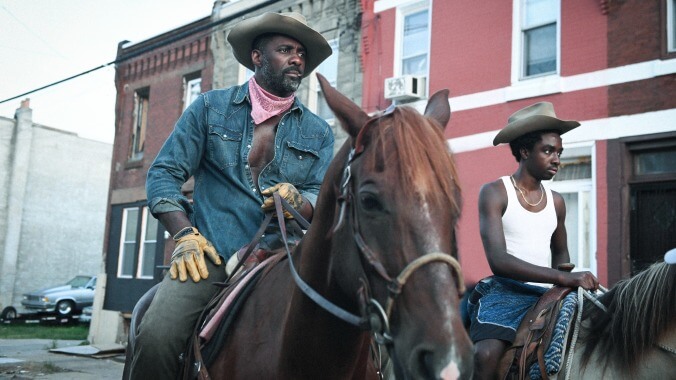Concrete Cowboy turns a unique subculture into a coming-of-age cliché

Much as the recent Charm City Kings did with dirt bike riders in Baltimore, Concrete Cowboy zeroes in on North Philadelphia’s Black cowboy enclave, a place where horse stables contrast with a rapidly gentrifying urban area. Positioning habitual tropes against this extraordinary setting, director Ricky Staub gallops through the coming-of-age story of a Black teen. On Fletcher Street, home to a fabled urban stable, troubled adolescent Cole (Caleb McLaughlin) receives a shot at redemption and growth when he lands back with his estranged father Harp (Idris Elba), a respected figure in these hay-laden parts.
Derived from the novel Ghetto Cowboy by G. Neri, this film iteration bargains in vague platitudes as it unsuccessfully tries to piece together a collage of factors threatening the viability of this one-of-a-kind place. Even if others deem it a faithful adaptation in terms of its content—which deviates little from a number of other adolescent sagas centered on underserved BIPOC youth—its scattered-brained, sample platter-like construction exposes the filmmaker’s “outsider looking in” lens, which persists despite Staub being from Philadelphia. In its over-explaining of certain contextual aspects about life in North Philly, the overall sentiment rings skin deep.
Everyone in the neighborhood seems familiar with an unspoken code to break down the arrogance of young men like Cole, prone to falling prey of illicit activities, with back-breaking labor; as he scoops up manure, veterans attempt to pass on lessons in both horsemanship and life. In the process, Cole superficially connects with one of the horses, infamous for its untamed behavior. It’s an allegory that juxtaposes the animal’s instinctual rejection of captivity to the Black riders’ defiant attitude toward the authorities and developers that want to put an end to their way of life. Simultaneously, by making Cole the only one who can communicate with the wild horse, the message turns muddled: The boy’s growing appreciation of this lifestyle and the quadruped’s eventual submission to him suggest that freedom comes with strict limits, correlation between man and horse that doesn’t work here as it does in Chloé Zhao’s The Rider.
While several cast members in supporting roles are real-life riders from Fletcher Street—just as some of the bikers in Charm City Kings were
also local non-actors—their presence doesn’t lend organic emotions or subtlety. Staub has everyone on screen speak in self-important speeches with noticeable exposition intentions, as if each line must convey meaningful information as opposed to resonating naturally with the world. The most useful use of such patters comes in a scene over a fire, where some history spills out about how the Fletcher Street Stables procured its precious racehorses from a livestock auction.
McLaughlin, of Stranger Things fame, delivers in terms of angst-fueled naiveté, playing a kid at the mercy of conflicting influences on opposite directions of the moral spectrum. Parallels with Charm City Kings and its protagonist continue in how Cole’s role models try to define who he should grow up to be as a Black male in this country. As his nearly non-verbal dad, Elba brings a macho nonchalance to the role that proves imposing whenever he is on screen. Yet, by design, his character gets little emotional depth other than a moment explaining why he abandoned his son. And even that confession comes with the caveat of divulging details in a conspicuous manner.
Then there’s Smush (Jharrel Jerome), Cole’s childhood friend pulling him in the direction of drug dealing. Despite Jerome’s inherent charisma, Smush’s fate is blatantly predictable, and the narrative makes little effort to trick the viewer into thinking he could have a different end. Similarly, Method Man co-stars as Leroy, a conflicted police officer from the community who sometimes chooses not to enforce the law for the greater good of his neighbors. Staub finds no room to examine that difficult position, beyond a couple of interventions to advance the plot.
For as much as Staub tries to cram into Concrete Cowboy, from displacement to Cole’s romance with a fellow rider, at least the film is stunningly shot. In the hands of cinematographer Minka Farthing-Kohl, the frames are suffused with thought-out personality. With a penchant for reflections, Farthing-Kohl points his camera at unusual surfaces to capture the action, whether it be a puddle or a car’s window. Night sequences, like one of Cole connecting with his horse during a tense standoff at a park, brim with an inviting luminosity. If only such artistic focus was also present narratively.
Concrete Cowboy and Charm City Kings sit on opposite extremes of the spectrum in regards to an outsider telling the story of a group that is not his own. Puerto Rican filmmaker Ángel Manuel Soto succeeded at the helm of the latter, in part because his duty was limited to directing. He realized a screenplay from writers close to the dynamics of that singular Baltimore environment. Conversely, Staub and co-writer Dan Walser took everything into their own hands. The result dilutes the most inspiring elements of the Black cowboys’ legacy by cluttering the drama with trite beats.